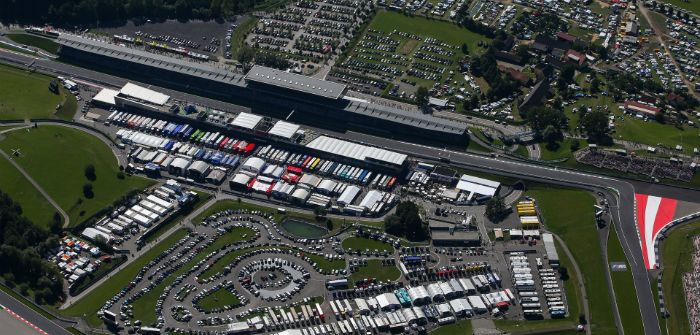It’s quite a hike up beyond the first corner at the Red Bull Ring. I know, because I dragged myself up there with a friend on the Saturday evening of the Austrian Grand Prix to see many legends in historic sportscars, who used that as the starting point for a hugely popular series of demonstration laps. They included Jean Alesi in Nick Mason’s 1970 Ferrari 512S; Gerhard Berger in 1999 BMW’s V12 LMR; Hans Stuck in a 1986/87 Rothmans Porsche 956; and Helmut Marko in a 1970 Porsche 917K.
In making the trek, I was also privileged to get a look at the official F1 Fanzone, which had been set up there. It was heaving. They had 145,000 spectators over the weekend, and it seemed at that moment as if all of them had congregated in the same place at once. While listening to the historic cars warming up and talking to several of the drivers, we could hear F1 drivers being interviewed in the Fanzone – where Daniel Ricciardo and Max Verstappen notably joked about their recent race in Spielberg towing caravans behind Aston Martins, and threatened to stage a dead heat victory for Red Bull in the Grand Prix.
There is no mistaking the new atmosphere in Formula 1 these days. It’s as if a cloud has been lifted from the F1 paddock, with the arrival of Liberty Media. People are happier. There is more an air of can do, than can’t.
Spectators can now enjoy fan zones at several tracks, participating in all manner of extra-race activities, which include zip lines and the F1 Experiences rides in the old two-seater Minardis, run, once again, by Paul Stoddart. The very successful recent London Live event was further indication of their wish to engage fans far more.
The findings of the latest fan survey conducted by Motorsport Network were also encouraging.
‘Formula 1 in 2017 – Global fan insight into the world’s largest annual sporting series (2005-2017)’ was commissioned, created, governed and delivered by Motorsport Network between March and May 2017.
Some 215,892 fans in 194 participating countries accessed the survey online during the 19-day fieldwork, and 148,170 completed responses were collected and submitted for analysis, making this the largest survey ever conducted in the sport. It was also the youngest-ever sample, with 26% of respondents aged under 26, and had an increased participation among female fans of 10%: A sharp increase in North, Central and South America.
And the survey revealed that the F1 brand is recovering. In 2015, the GPDA / Motorsport Network.com Study documented a sport in crisis. The new one suggests it is in far better health, records a welcome wave of optimism among fans, and a sharp decline in negative attributes.
In 2015, descriptors such as Boring, Corrupt and Threatened abounded. This time around, others such as Exciting, Technological, Competitive, Prestigious, Innovative, World Class and Entertaining showed marked increases. There were strong indications it is recovering from Bernie Ecclestone’s ‘Ratner moment’ in 2014 when he demeaned it publicly.
Fans strongly favor a season of between 19 and 21 races, but they want full-length, live races and they want them free to watch.
Asked to name their favorite must-have (must-keep) tracks, they nominated Monaco, Monza, Silverstone and Spa. Old-school venues. (I believe both sides are intelligent enough in the situation between Liberty and Silverstone for things to be resolved within the next two years.)
But they fired a warning shot that ticket prices are still too high. But some of the best pointers of all came under the sporting changes section. Fans want: annual team budget caps, teams to be able to run customer cars, championship points for fastest laps, refueling, a return to V8 engines, and competition between tire manufacturers.
And they don’t want: sprinkler systems, success ballast, reverse grids, rapid-degradation tires, or event changes such as Saturday races, third driver races, or two shorter races per weekend.
Of course it’s not all been good news, and ironically the bad has come not from the new guys, but from the old.
Jean Todt’s feeble effort in letting Sebastian Vettel off without further penalty after his road rage incident in Baku was further evidence of the need for change in the sport’s governance, given that he had done the same in Mexico last year after another of the quadruple champion’s temper tantrums. He then compounded that error of judgement by overruling the Strategy Group, which had earlier voted against the Halo cockpit protection device, and mandated it after all for 2018. The alternative, the Shield, had done only one lap of testing at Silverstone, on Vettel’s Ferrari.
Clearly, while some areas of the sport are moving in the right direction, others are not.



